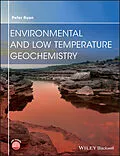Environmental and Low-Temperature Geochemistry presents conceptual and quantitative principles of geochemistry in order to foster understanding of natural processes at and near the earth's surface, as well as anthropogenic impacts on the natural environment. It provides the reader with the essentials of concentration, speciation and reactivity of elements in soils, waters, sediments and air, drawing attention to both thermodynamic and kinetic controls. Specific features include: * An introductory chapter that reviews basic chemical principles applied to environmental and low-temperature geochemistry * Explanation and analysis of the importance of minerals in the environment * Principles of aqueous geochemistry * Organic compounds in the environment * The role of microbes in processes such as biomineralization, elemental speciation and reduction-oxidation reactions * Thorough coverage of the fundamentals of important geochemical cycles (C, N, P, S) * Atmospheric chemistry * Soil geochemistry * The roles of stable isotopes in environmental analysis * Radioactive and radiogenic isotopes as environmental tracers and environmental contaminants * Principles and examples of instrumental analysis in environmental geochemistry The text concludes with a case study of surface water and groundwater contamination that includes interactions and reactions of naturally-derived inorganic substances and introduced organic compounds (fuels and solvents), and illustrates the importance of interdisciplinary analysis in environmental geochemistry. Readership: Advanced undergraduate and graduate students studying environmental/low T geochemistry as part of an earth science, environmental science or related program. Additional resources for this book can be found at: href="http://www.wiley.com/go/ryan/geochemistry">www.wiley.com/go/ryan/geochemistry.
Autorentext
Peter Crowley Ryan is Professor of Geology and Environmental Studies at Middlebury College where he teaches courses in environmental geochemistry, hydrology, sedimentary geology and interdisciplinary environmental science. He received a Ph.D. in geology at Dartmouth College, an M.S. in geology from the University of Montana and a B.A. in earth sciences from Dartmouth College. He has served as Director of the Program in Environmental Studies and as Chair of the Department of Geology at Middlebury College. His research interests fall into two main areas: (1) understanding the geological and mineralogical controls on trace-element speciation, particularly the occurrence and mobility of arsenic and uranium in bedrock aquifers; and (2) the temporal evolution of marine terrace soils in the tropics, with emphasis on mechanisms and rates of mineralogical reactions, nutrient cycling and application of soil geochemical analysis to correlation and geological interpretation.
Klappentext
Environmental and Low Temperature Geochemistry presents the conceptual and quantitative principles of geochemistry in order to foster an understanding of natural processes at and near the Earth's surface, as well as anthropogenic impacts on the natural environment. It provides the reader with the essentials of concentration, speciation and reactivity of elements in soils, waters, sediments and air, drawing attention to both thermodynamic and kinetic controls. Specific features include:
- An introductory chapter that reviews basic chemical principles applied to environmental and low-temperature geochemistry
- Explanation and analysis of the importance of minerals in the environment
- Principles of aqueous geochemistry
- Organic compounds in the environment
- The role of microbes in processes such as biomineralization, elemental speciation and reduction-oxidation reactions
- Thorough coverage of the fundamentals of important geochemical cycles (C, N, P, S)
- Atmospheric chemistry
- Soil geochemistry
- The roles of stable isotopes in environmental analysis
- Radioactive and radiogenic isotopes as environmental tracers and environmental contaminants
- Principles and examples of instrumental analysis in environmental geochemistry
The text concludes with a case study of surface water and groundwater contamination that includes interactions and reactions of naturally derived inorganic substances and introduced organic compounds (fuels and solvents), and illustrates the importance of interdisciplinary analysis in environmental geochemistry.
Readership: Advanced undergraduate and graduate students studying environmental/low T geochemistry as part of an earth science, environmental science or related program.
Zusammenfassung
Environmental and Low-Temperature Geochemistry presents conceptual and quantitative principles of geochemistry in order to foster understanding of natural processes at and near the earth's surface, as well as anthropogenic impacts on the natural environment. It provides the reader with the essentials of concentration, speciation and reactivity of elements in soils, waters, sediments and air, drawing attention to both thermodynamic and kinetic controls. Specific features include:
• An introductory chapter that reviews basic chemical principles applied to environmental and low-temperature geochemistry
• Explanation and analysis of the importance of minerals in the environment
• Principles of aqueous geochemistry
• Organic compounds in the environment
• The role of microbes in processes such as biomineralization, elemental speciation and reduction-oxidation reactions
• Thorough coverage of the fundamentals of important geochemical cycles (C, N, P, S)
• Atmospheric chemistry
• Soil geochemistry
• The roles of stable isotopes in environmental analysis
• Radioactive and radiogenic isotopes as environmental tracers and environmental contaminants
• Principles and examples of instrumental analysis in environmental geochemistry
The text concludes with a case study of surface water and groundwater contamination that includes interactions and reactions of naturally-derived inorganic substances and introduced organic compounds (fuels and solvents), and illustrates the importance of interdisciplinary analysis in environmental geochemistry.
Readership: Advanced undergraduate and graduate students studying environmental/low T geochemistry as part of an earth science, environmental science or related program.
Additional resources for this book can be found at: www.wiley.com/go/ryan/geochemistry.
Inhalt
Acknowledgements xii
About the Companion Website xiii
1 Background and Basic Chemical Principles: Elements, Ions, Bonding, Reactions 1
1.1 An overview of environmental geochemistry - history, Scope, Questions, Approaches, challenges for the future 1
1.2 The naturally occurring elements - origins and abundances 2
1.3 Atoms and isotopes: a brief review 6
1.4 Measuring concentrations 8
1.4.1 Mass-based concentrations 8
1.4.2 Molar concentrations 9
1.4.3 Concentrations of gases 10
1.4.4 Notes on precision and accuracy, significant figures and scientific notation 10
1.5 Periodic table 11
1.6 Ions, Molecules, Valence, Bonding, chemical reactions 14
1.6.1 Ionic bond strength 14
1.6.2 Covalent bonds 16
1.6.3 Electronegativity 17
1.6.4 Metallic bonds, hydrogen bonds and van der Waals forces 18
1.7 Acid-base equilibria, pH, K values 19
1.8 Fundamentals of redox chemistry and chemical reactions 21
1.9 Chemical reactions 23
1.10 Equilibrium, thermodynamics and driving force…
